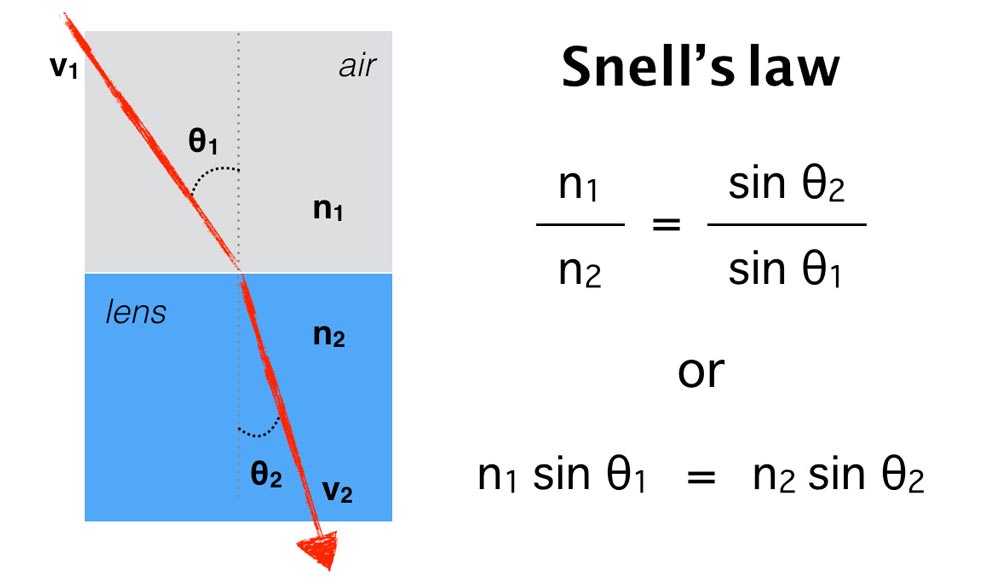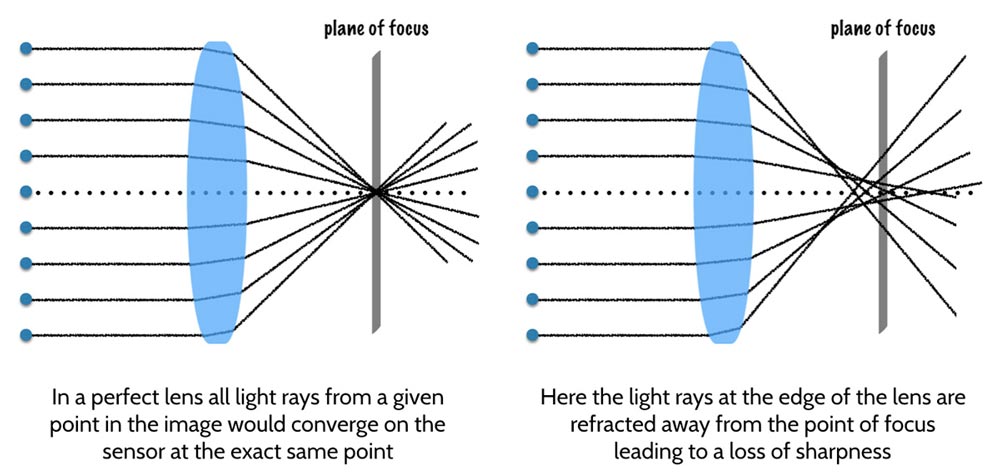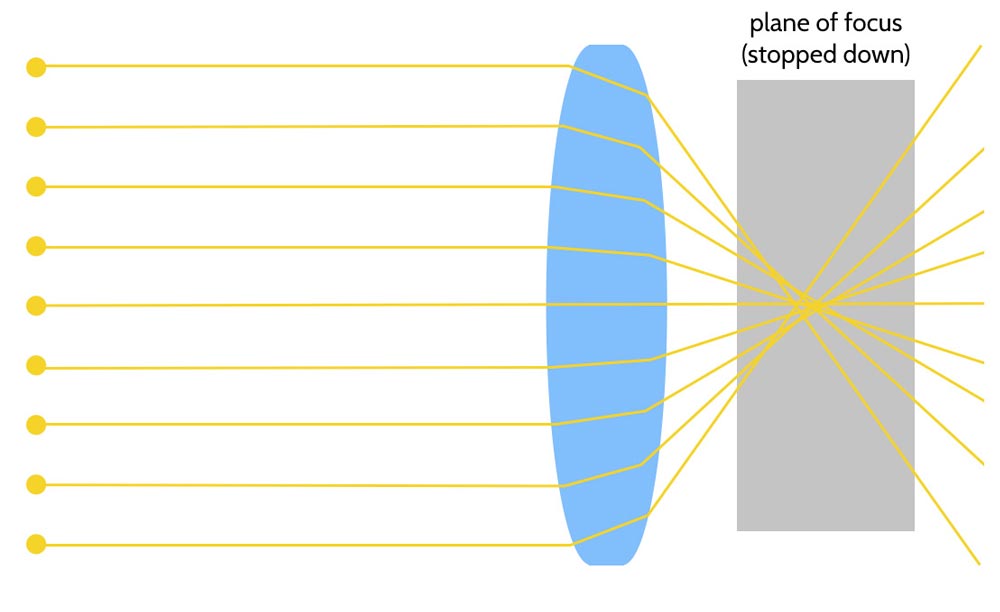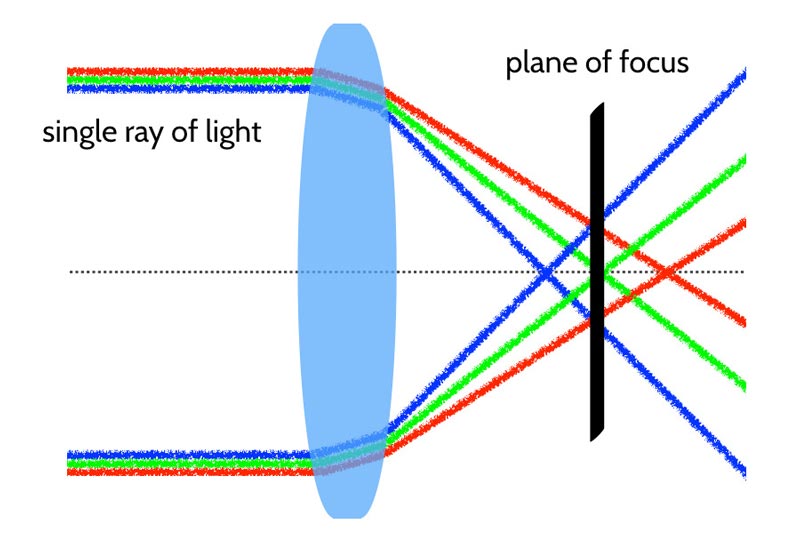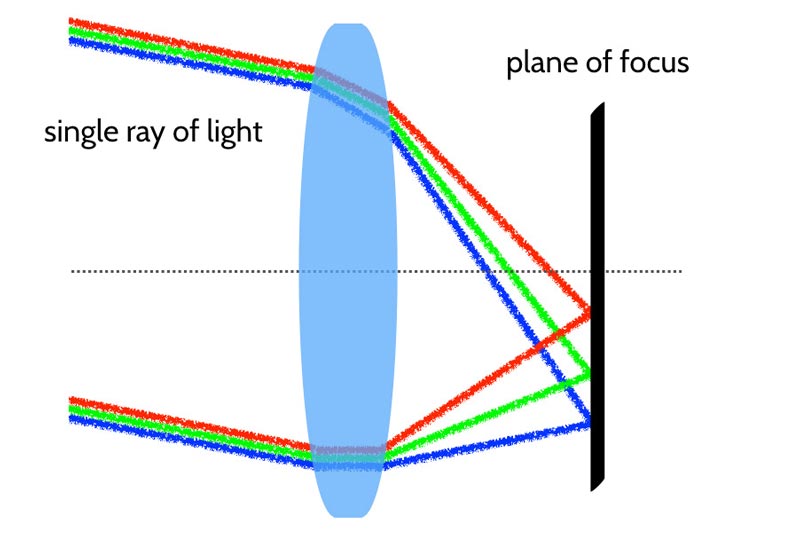Aberrations are imperfections in the optics of the camera lens and result in image deterioration. Different lenses will be affected by aberrations to varying degrees and in some cases these unwanted effects can be mitigated by stopping down or through lens correction algorithms built into higher-end cameras. There are two types of aberrations that concern us in photography—spherical and chromatic.
Bending of Light
The job of the lens in any photographic system is to focus the light entering the lens onto the sensor. A concave piece of glass is the most basic part of the lens used to achieve this result. Through refraction—the bending of light when it passes through a different medium—the light that enters the lens is focused onto the sensor or film. This bending happens because waves travel at different speeds through different mediums. For example, light will travel faster through a vacuum than through air or glass.
The relationship between the speed of light in a vacuum and the speed through which it travels in another medium is given by its refractive index, n:
n = c/v
… where c is the speed of light in a vacuum and v is the speed of light through the substance in question. For instance, the refractive index of water is 1.33. This means that light travels 1.33 times slower through water than it does through a vacuum.
Snell’s Law shows how the change in the refractive index from one medium to the other relates to the angle at which the light is refracted; but, essentially, the greater the relative refractive index the greater the angle of refraction. Glass, depending on the composition and quality, has a refractive index typically between 1.5-1.7. Consequently, light bends more entering glass from a vacuum than it does entering water from a vacuum.
Unfortunately, lenses are not perfect and they cannot always make light rays bend as we want them too. Moreover, the challenge of focusing is made all the more difficult because the refractive index also depends on the wavelength!
Spherical Aberrations
Spherical aberrations are responsible for the “softer” images we often get when shooting at or close to wide-open on a fast lens. They occur due to the increased refraction at the edge of the lens versus the centre (where the light ray hits the glass at a more acute angle) and result in rays not converging on the same focal point.
The effects of spherical aberrations can be reduced by stopping down the lens and thus widening the plane of focus, but obviously at the expense of losing that ‘punchiness’ which is the reason we pay so much for fast lenses (along with the ability to shoot in low light). The result in the final image is less defined detail locally when compared to shooting at a mid-range aperture (compare the text at ƒ/2 vs ƒ/8).
By stopping down the lens you are creating a wider depth of field and thus giving the lens a wider target in which it must get the rays of light to converge.
Chromatic Aberrations
Chromatic aberrations occurs because the the degree to which the lens refracts light depends on the wavelength. In other words, it fails to make all colours in a ray of light converge at the same point sometimes resulting in undesirable colour fringing as can be seen in the photograph below.
As mentioned above, the refractive index depends not only on the speed of the wave through the medium but also on its wavelength. For glass, the refractive index increases slightly with wavelength over the visible spectrum. This means that colours at the shorter end of the spectrum (e.g. blue) are more dispersed by glass than those at the longer end (e.g. red). It is this phenomenon which explains the rainbow of colours seen when light is shone through a prism. Thinking about photography and the need to focus all visible colours on a single point we can see a problem concave glass presents:
The diagram above represents what we call longitudinal (or axial) chromatic aberration. This type of chromatic aberration can be addressed by stopping down the lens because this widens the plane of focus, thus giving the rays a wider area in which to converge to avoid noticeable image deterioration (similar to how we could mitigate the effects of spherical aberrations by stopping down).
Another type of chromatic aberration is lateral (or transverse) chromatic aberration. This rests on the same concepts as above but arises from colours hitting the plane of focus at different vertical points. It is normally only visible at the corners in high contrast images in the form of purple fringing (like in the photograph above).
Unlike its longitudinal sibling, it cannot be corrected by stopping down the lens (the issue is unrelated to the depth of the plane of focus). Some modern DSLRs allow users to pre-load a lens profile, using which the camera runs algorithms to compensate for the effect of lateral chromatic aberrations.
The idea of a camera lens as a single piece of concave glass is obviously too simplistic and the impact of aberrations is drastically reduced (but not entirely eliminated) through lens design and compounding multiple pieces of glass to correct for unwanted physical effects.
